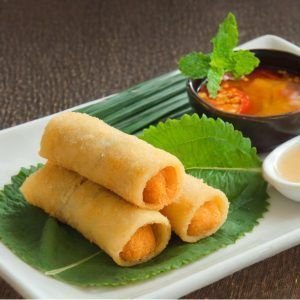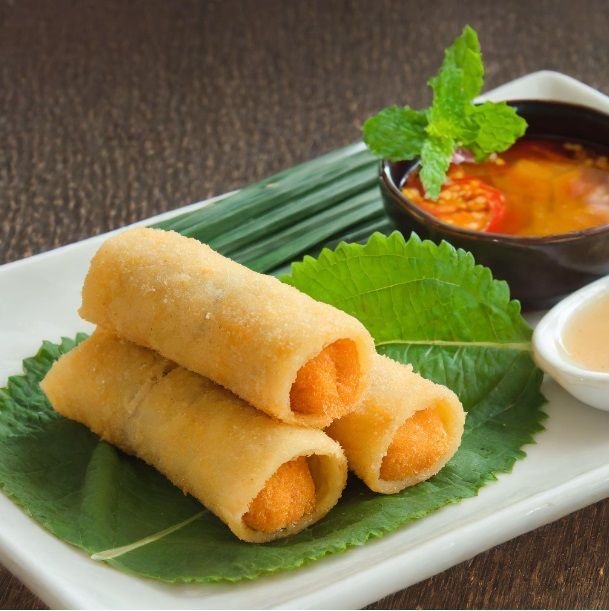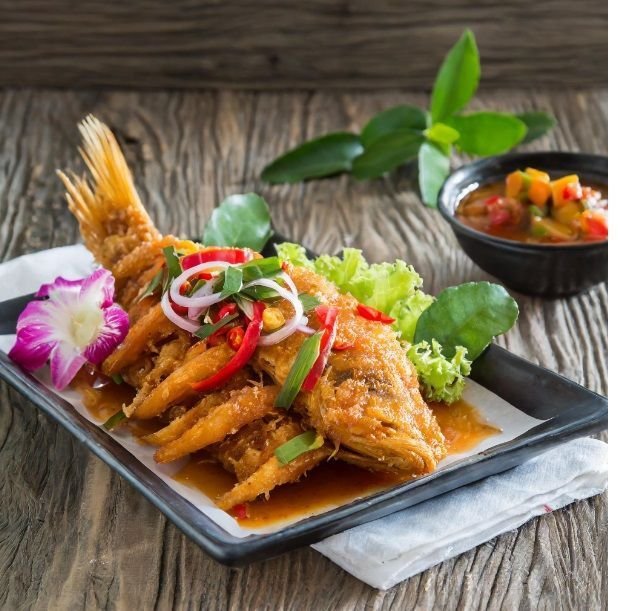Ningbo fried fish roll
Ningbo Fried Fish Roll with bean curd sheets : A Delicious Recipe from East China
Ingredients for our trending recipes:
For the Fish Roll:
- 500g white fish fillets (such as sea bass or cod)
- 1 tablespoon Shaoxing wine
- 1 teaspoon salt
- 1/2 teaspoon white pepper
- 1 tablespoon cornstarch
- 1 egg white
- 1 tablespoon minced ginger
- 2 spring onions, finely chopped
- 1 tablespoon soy sauce
- 1 tablespoon sesame oil
- 1/4 cup water chestnuts, finely chopped
- 1/4 cup bamboo shoots, finely chopped
- 1/4 cup carrots, finely chopped
- 1/4 cup shiitake mushrooms, finely chopped
- Vegetable oil for frying
For the Dipping Sauce:
- 3 tablespoons soy sauce
- 1 tablespoon rice vinegar
- 1 teaspoon sugar
- 1 teaspoon sesame oil
- 1 teaspoon minced ginger
- 1 teaspoon minced garlic
- 1 teaspoon chili oil (optional)
- Chopped spring onions for garnish
Instructions:
1. Prepare the Fish Mixture:
- In a bowl, combine the fish fillets, Shaoxing wine, salt, white pepper, cornstarch, and egg white. Mix well to combine.
- Add the minced ginger, chopped spring onions, soy sauce, sesame oil, water chestnuts, bamboo shoots, carrots, and shiitake mushrooms to the fish mixture. Stir until evenly distributed.
2. Form the Fish Rolls:
- Take a portion of the fish mixture and shape it into a small rectangular roll, about 2 inches long and 1 inch thick. Repeat with the remaining mixture.
3. Fry the Fish Rolls:
- Heat vegetable oil in a deep fryer or large skillet to 350°F (180°C).
- Carefully lower the fish rolls into the hot oil, a few at a time, and fry until golden brown and crispy, about 5-6 minutes. Ensure the rolls are cooked through by testing with a fork or skewer.
- Once cooked, remove the fish rolls from the oil and drain on paper towels to remove excess oil. Repeat with the remaining rolls.
4. Prepare the Dipping Sauce:
- In a small bowl, combine soy sauce, rice vinegar, sugar, sesame oil, minced ginger, minced garlic, and chili oil (if using). Mix well until the sugar is dissolved.
5. Serve the Fish Rolls:
- Transfer the fried fish rolls to a serving platter and garnish with chopped spring onions.
- Serve hot with the prepared dipping sauce on the side.
6. Enjoy Your Ningbo Fried Fish Rolls!
- These delicious fish rolls are crispy on the outside and tender on the inside, with a flavorful filling of vegetables and aromatic spices. Dip them in the savory-sweet dipping sauce for an extra burst of flavor. Enjoy as an appetizer or main dish, paired with steamed rice or noodles, for a satisfying meal inspired by the culinary traditions of East China.

Exploring the Culinary Heritage of Ningbo in East China
Ningbo China.
Ningbo, located in the Zhejiang Province of East China, boasts a rich culinary heritage deeply rooted in its history, geography, and cultural influences. As one of China’s oldest cities, Ningbo has been a hub of trade and commerce for centuries, attracting merchants, travelers, and scholars from across Asia and beyond.
This bustling port city is renowned for its fresh seafood, flavorful sauces, and delicate preparation techniques, making it a gastronomic delight for food enthusiasts. In this article, we will delve into the culinary traditions of Ningbo, exploring its unique ingredients, iconic dishes, dining culture, and the influence of its rich history on its vibrant food scene.
1. Geography and Climate: Ningbo’s location along the coast of the East China Sea has shaped its culinary landscape, providing access to an abundance of fresh seafood, including fish, shellfish, and crustaceans. The region’s temperate climate and fertile land also contribute to the cultivation of a variety of fruits, vegetables, and herbs, which are essential ingredients in Ningbo cuisine.
2. Ingredients and Flavors: Ningbo cuisine is characterized by its emphasis on fresh, seasonal ingredients and simple yet flavorful cooking techniques. Some of the key ingredients used in Ningbo dishes include:
- Seafood: Fresh fish, shrimp, crab, and clams are staples of Ningbo cuisine, often steamed, stir-fried, or braised to preserve their natural flavors.
- Vegetables: Locally grown vegetables such as bamboo shoots, water chestnuts, and leafy greens are commonly used in Ningbo dishes, adding texture and color to the cuisine.
- Sauces and Condiments: Ningbo cuisine is known for its flavorful sauces and condiments, including soy sauce, rice vinegar, Shaoxing wine, sesame oil, and fermented bean paste, which enhance the taste of dishes without overpowering the natural flavors of the ingredients.
3. Iconic Dishes of Ningbo Cuisine: Ningbo cuisine features a wide array of delicious dishes, each showcasing the region’s culinary expertise and dedication to quality ingredients. Some iconic dishes include:
- Ningbo Steamed Fish: Fresh fish, typically a variety of white fish such as sea bass or carp, is steamed with ginger, scallions, soy sauce, and Shaoxing wine, resulting in a delicate and flavorful dish that highlights the natural sweetness of the fish.
- Ningbo-Style Braised Pork Belly: Tender pork belly is braised in a savory-sweet sauce made from soy sauce, sugar, ginger, garlic, and spices, resulting in melt-in-your-mouth meat with rich, complex flavors.
- Ningbo Fried Shrimp with Longjing Tea: Fresh shrimp are marinated in a mixture of Longjing tea, soy sauce, and spices, then deep-fried until crispy and golden brown, creating a dish that combines the delicate flavors of seafood with the fragrant aroma of green tea.
4. Dining Culture and Traditions: In Ningbo, dining is not just about nourishment but also a social and cultural experience that brings people together to share good food and conversation. Traditional Ningbo restaurants, known as “mifan guan” or “fan guan,” serve a variety of home-style dishes in a cozy and welcoming atmosphere, reminiscent of a family kitchen.
Dining etiquette in Ningbo is relatively informal, with an emphasis on enjoying food with friends and family while savoring the flavors and textures of each dish.
5. Culinary Influences and Innovations: Over the centuries, Ningbo cuisine has been influenced by various culinary traditions, including those of neighboring regions such as Shanghai, Hangzhou, and Suzhou.
This cross-cultural exchange has led to the development of unique dishes and flavor combinations that reflect Ningbo’s diverse culinary landscape. In recent years, Ningbo has also seen a rise in culinary innovation, with chefs and restaurateurs experimenting with new techniques, ingredients, and presentations to showcase the region’s culinary heritage in a modern context.
6. Conclusion: Ningbo cuisine is a celebration of the region’s rich history, cultural diversity, and culinary creativity. From its fresh seafood and seasonal vegetables to its flavorful sauces and iconic dishes, Ningbo offers a gastronomic experience that is both satisfying and memorable.
Whether enjoyed in a traditional mifan guan or a contemporary restaurant, Ningbo cuisine continues to captivate food enthusiasts with its timeless flavors, vibrant colors, and exquisite craftsmanship, reaffirming its status as a culinary gem in the heart of East China.

Bamboo Shoots: Versatile and Nutritious Ingredients in Asian Cuisine
Bamboo shoots, the tender and edible sprouts of bamboo plants, have been a staple ingredient in Asian cuisine for centuries. With their delicate flavor, crunchy texture, and nutritional benefits, bamboo shoots feature prominently in a wide variety of dishes across different Asian cultures.
From stir-fries to soups, salads to curries, bamboo shoots add depth, flavor, and nutritional value to Asian culinary creations. In this comprehensive article, we will explore the versatile usage of bamboo shoots in Asian dishes, their nutritional profile, culinary significance, and cultural heritage.
1. Cultural Significance: Bamboo shoots hold a special place in Asian culinary traditions, symbolizing resilience, vitality, and renewal. In many Asian cultures, bamboo is revered for its strength and adaptability, with bamboo shoots representing new beginnings and the promise of growth.
As such, bamboo shoots are often featured in celebratory meals and festival dishes, signifying prosperity, abundance, and good fortune.
2. Culinary Usage: Bamboo shoots are prized for their versatility and adaptability in cooking, lending themselves to a wide range of culinary applications. Some common methods of preparing bamboo shoots include:
- Stir-frying: Bamboo shoots are frequently used in stir-fries, where they add a crisp texture and subtle flavor to dishes. They pair well with various proteins such as chicken, pork, beef, and seafood, as well as a variety of vegetables and aromatics.
- Soups and stews: Bamboo shoots are often added to soups and stews, where they contribute a unique texture and flavor profile. They absorb the flavors of the broth or sauce, enhancing the overall taste of the dish.
- Salads and pickles: In some Asian cuisines, bamboo shoots are used in salads and pickles, where they provide a crunchy texture and refreshing taste. They can be marinated or pickled in vinegar-based dressings, adding a tangy kick to salads and appetizers.
3. Nutritional Benefits: Bamboo shoots are not only delicious but also nutritious, offering a range of health benefits. They are low in calories and fat, making them a healthy addition to any diet. Some of the key nutritional benefits of bamboo shoots include:
- High in fiber: Bamboo shoots are a good source of dietary fiber, which aids digestion, promotes satiety, and helps regulate blood sugar levels.
- Rich in vitamins and minerals: Bamboo shoots contain essential vitamins and minerals, including vitamin C, vitamin A, potassium, calcium, and manganese, which support overall health and well-being.
- Antioxidant properties: Bamboo shoots contain antioxidants such as phenolic compounds and flavonoids, which help protect cells from damage caused by free radicals and oxidative stress.
4. Culinary Significance: In many Asian cultures, bamboo shoots are associated with traditional cooking methods, regional cuisines, and seasonal ingredients.
They are often harvested in the spring when they are young and tender, then prepared and preserved for use throughout the year. Bamboo shoots are also valued for their sustainability and eco-friendly qualities, as bamboo plants grow rapidly and require minimal resources to cultivate.
5. Popular Bamboo Shoot Dishes: Bamboo shoots are featured in a wide variety of Asian dishes, ranging from appetizers to main courses, side dishes to condiments. Some popular bamboo shoot dishes include:
- Stir-fried bamboo shoots with pork: Thinly sliced bamboo shoots are stir-fried with thinly sliced pork, garlic, ginger, and soy sauce, creating a savory and aromatic dish.
- Bamboo shoot curry: Bamboo shoots are simmered in a fragrant curry sauce made from coconut milk, curry paste, spices, and herbs, resulting in a creamy and flavorful curry dish.
- Bamboo shoot salad: Thinly sliced bamboo shoots are tossed with shredded carrots, cucumbers, and herbs, then dressed with a tangy vinaigrette, creating a refreshing and light salad.
6. Bamboo shoots are versatile, nutritious, and delicious ingredients that play an essential role in Asian cuisine. Whether stir-fried, simmered, pickled, or served fresh, bamboo shoots add texture, flavor, and nutritional value to a wide range of dishes.
As a symbol of resilience and vitality, bamboo shoots continue to inspire chefs and home cooks alike, contributing to the rich tapestry of flavors and traditions that define Asian culinary heritage. By exploring the culinary significance and culinary applications of bamboo shoots, we gain a deeper appreciation for their role in Asian cuisine and their contribution to flavorful and wholesome dishes enjoyed by people around the world.





